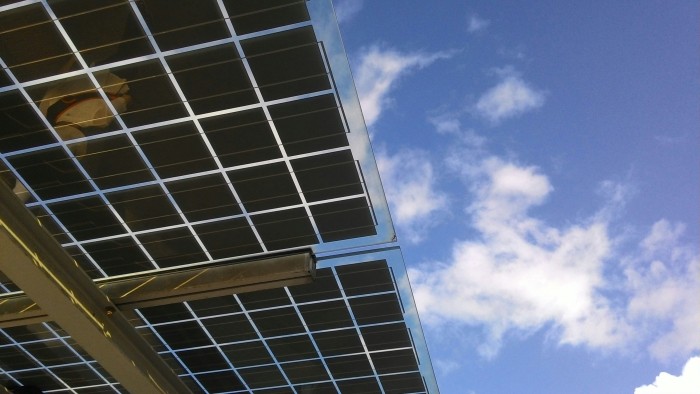Strategizing Solar and Storage at Scale

In Brief:
- Yale's Clean and Equitable Energy Development (CEED) Certificate Program, through CBEY, gives participants the opportunity to develop and assess clean energy projects that are intended to provide local communities with financial, social, and environmental benefits.
- One team worked on a project for Doña Ana County in New Mexico.
- The proposal is a 150 MW solar, and 50 MW battery storage project designed to help El Paso Electric meet its 2045 renewable energy targets.
- The project’s scale matches its vision for equity: beyond site viability and transmission access; the team built in workforce training, tribal partnerships, and local ownership pathways.
- Yale Clean Energy Forum interviewed the Doña Ana County team to gain insight about the impact of this project.
What made Doña Ana County the right location for a project of this scale and ambition?
Doña Ana County offers a unique combination of high solar irradiance (5.8–6.2 kWh/m²/day), state-leased commercial-zoned land, and political support for renewable energy. The 1,100-acre site we selected is not only cost-effective at ~$25,000/year lease, but it’s also ideally situated near El Paso and Las Cruces—two growing load centers. The area has existing transmission corridors and access to the Southwest Power Pool (SPP), allowing scalable interconnection and export potential. Local and state incentives, a strong pro-renewables stance, and a history of utility-scale solar (e.g., Milagro and First Solar projects) reinforce its viability.
Our solution is both selling electrons and battery storage. We would interconnect with the Vada Substation and also trade daily on the energy marketplace. Resources available in the area (the land, the sun, the incentives from the government, etc.) are so good that our strategy is to be a facility with a diversified revenue generation stream rather than a large facility.
How does the design support El Paso Electric’s 2045 renewable energy goals—and what gaps does it help close?
The project directly aligns with El Paso Electric’s (EPE) goal of achieving 100% clean energy by 2045. By choosing to interconnect at the new Vado Substation, we complement EPE’s capacity expansion plans. Additionally, our commitment to domestic content and equity-focused Investment Tax Credit incentives enables EPE to meet both environmental and social governance benchmarks, closing the gap between ambition and inclusive implementation.
How are equity considerations—like tribal partnerships and local ownership—integrated from the start?
From inception, equity was built into our strategy. We prioritize collaboration with tribal entities like the Piro/Manso/Tiwa Tribe of Guadalupe Pueblo and Mescalero Apache Tribe, exploring local ownership options and cultural consultation. We design for Inflation Reduction Act adders tied to tribal lands, low-income communities, and domestic content. Our procurement approach centers Minority and Women-Owned Business Enterprise inclusion and our plan includes Community Benefits Agreements that reserve project revenue for reinvestment in underserved areas. We’re also exploring partnerships with Native-owned firms like Sacred Power, increasing both economic inclusion and incentive eligibility.
What does the workforce training component look like, and who stands to benefit most from it?
Workforce training is in partnerships with Doña Ana Community College (DACC) and New Mexico State University (NMSU), both of which offer renewable energy curricula. We would design apprenticeship and certification pathways for local residents, targeting low- and moderate-income (LMI) and tribal communities. The plan includes solar installation, maintenance, and storage system training. This program will particularly benefit local young adults and displaced workers in the Dona Ana areas, creating a renewable energy job pipeline that can be replicated.
What challenges or limitations are you encountering around transmission infrastructure or interconnection feasibility?
The main challenge is queue congestion in EPE’s interconnection pipeline—19 projects are already in analysis, with timelines stretching to 2027. However, our selected site near the Vado Substation has >1.1GW of capacity proposed to come online by 2028, which aligns with our development timeline. We’ve structured the project to avoid costly utility upgrades and interconnect at a scale (150MW) that can potentially be fast-tracked within the upcoming cluster study. While waitlisting and interconnection cost variability remain risks, our proactive engagement with EPE and early technical assessments help mitigate this.
In what ways do community engagement or tribal consultation shape the project design?
The project is designed in a way that incorporates community engagement from the start. The plan implements an inclusive engagement framework through a Community Advisory Board, by conducting bilingual outreach, and in aligning project milestones with community feedback loops. Input from local tribal leaders helps avoid culturally sensitive land use and informs our site selection strategy. Engagement with community organizations like Ngage New Mexico and the Empowerment Congress of Doña Ana County influences our approach to LMI carve-outs, educational programs, and benefit-sharing mechanisms.
If this project moves beyond the proposal phase, what would be the first three steps toward implementation?
- Secure Interconnection Study & PPA Negotiation: Finalize participation in the Vado Substation cluster study and initiate long-term PPA discussions with El Paso Electric.
- Permitting & Environmental Studies: Launch full site survey, biological assessment, and permitting process through state and local agencies.
- Formalize Community and Tribal Partnerships: Finalize Community Benefit Agreements, tribal MOUs, and workforce training plans in collaboration with NMSU and DACC.